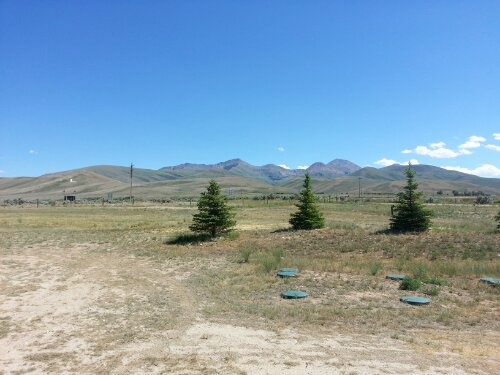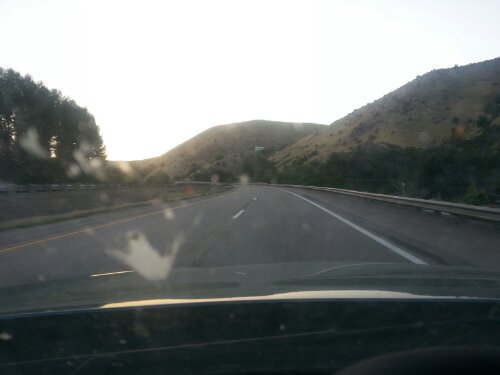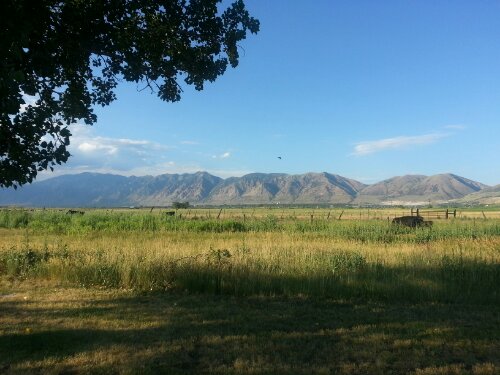Monthly Archives: July 2013
Smithsonian.com and PBS have a great story about how a a bunch of artists used smoke and mirrors to fool the Nazis.
According to some, a cracked cellphone screen is a new status symbol, of sorts. Like pre-frayed hats, I guess.But only if you can actually afford a new one, or something. We’ve turned smartphone functionality into something irony-based.
This is certainly my experience: Online dating makes us choosier. On the other hand, maybe that’s why the higher success rates?
Online dating has been good for gays, too, in accepting their sexuality.
An intriguing idea for online dating: Telling you what you’re doing wrong.
Your brain knows a phony smile when it sees one.
Research Digest has a cool piece on the intuition of homicide detectives.
We could be flying faster than we do, but we’re too thrifty. Well, there are definite environmental upsides, I suppose.
In the aftermath of Newtown, a lot of people who wanted to talk about the gun culture wanted to keep video game culture off-limits. That’s not so easy.
David Lloyd, the artist behind V for Vendetta, talks about the Guy Fawkes mask‘s embrace by radicals and protestors worldwide.
Smarter folks than me keep saying that technology cannot destroy jobs past the short term. I guess every generation thinks it, but I do wonder the extent to which “it’s different this time.”
I end up reading a lot of reviews for new smartphones because I am a geek and that is the sort of thing that interests me despite the fact that I am not really in the market for a new one.
The constant emphasis in the smartphone world is on the thickness or slenderness of the device. Almost uniformly, slender is considered better. Which is great, up to a point. I have to confess that when I hold some of my earlier smartphones, I am taken aback by how thick they are. I wonder how it didn’t bother me.
Here is the problem: The increased thinness has come at the expense of sturdiness. Which is a tradeoff without normative value. Except when it reaches the point where the phones are so fragile that you have to put them in a case. At that point, it really sort of defeats the purpose of it being thin to begin with, doesn’t it?
I remember a review of phones that on the one hand talk about how nice and slim the phones are. They also talk about how nice or not-nice the exterior of the device is. And yet then also talks about how “of course you will want a case”… presumably to protect the phone which is to slim to reliably survive being dropped. And certainly covering the exterior they were complementing.
I cannot tell you how many times I dropped my Samsung Stratosphere and the HTC Touch Pro 2 I had before it and the HTC Fuze I had before that and the HTC TyTn I had before that. None of them broke after repeated drops. They got chipped around the edges, and the battery and/or stylus would eject, and sometimes the latter would get lost, but that would be about the extent of it.
I dropped my Samsung Galaxy S3 once and only once without its protective coating, and it has a crack all along its front. For a while I had it in a protective case, which made it sturdier but defeated the purpose of the phone being so thin. I am willing to bet that if the S3 had a keyboard, the screen wouldn’t have cracked just as the screen from the Strat never cracked. Or even without a keyboard, a little more thickness in the device might obviate the need for an even thicker case.
I suppose this will cease to be an issue once we have the sapphire or Gorilla-Glass screens, or something similar, which will make the devices more droppable. It’s still an odd disconnect, though, in my view.
Here’s a picture of what Antarctica looks like under all that ice. Also, pockmarks we’ve given Earth.
MIT Tech Review looks at how self-driving vehicles are outstripping regulators’ ability to regulate them.
Ron Unz has a great piece on the collective failures of our media.
Food trucks: Feeding employees, and possibly keeping them around.
Floating buildings! I dig it.
An unexpected benefit of nuclear bombs: Brain regeneration in humans.
I like my oversized smartphone. Next time, I may go all-in and get a Note. That being said, for a lot of people, the drawbacks can be pretty significant. It can, for instance, make you lose your friend. Of course, there is a solution to this: Everyone wears pants, a belt, and a phone holster. Problem solved!
One of these days, I’m going to sit down and read as much about seasteading as I can.
It’s a tl;dr world.
The top foreign-language shows you can see legally in the US. I got my fill of subtitles during my anime days, which is a bit of a shame because I do like foreign entertainment.
One of the interesting things during my 1946-60 US History class was how tough the smart set was on Dwight Eisenhower. Often, compared unfavorably to Lincoln. As it ever was…
Here’s a cool interactive map where you can watch housing prices rise and fall.
Are the results of the Milgram Experiment overstated?
Too many heroes become dead heroes. In some situations, more would-be heroes are dying than those killed initially.
What happens when galaxies collide.
Mara Wilson has an insider’s prospective on why child stars go off the deep end.
A cool algorishm finds face-like structures on Earth’s surface.
An interesting look at why China’s filmmakers hate Japan, and why it matters. Over 200 anti-Japanese films come out of China a year.
Water from a Canadian mine appears to be over a billion years old.
Joblessness kills. Which is why, if we ever reach a post-employment future, it can’t actually become a post-employment future. (Yes, they did control for the usual suspects.)
How superhero storytelling has infected movies and other entertainment. And not for the better.
We may be able to watch sporting events in hologram. It’s an interesting concept, though I have mixed feelings on how fun that would be in practice.
The car-buying flow chart. It suggested a Ford C-Max to me.
Apparently, used video games allow publishers to charge more for new ones.
The suburbanization of British Jews and Indians.
Swedish college is free, but their students get out with almost as much student debt as our students do.
James Pethokoukis has some good ideas on how to reconcile climate change intervention with conservatism. The US Energy Secretary wants to find ways to capture carbon dioxide on the cheap. If anything will save us, it’ll be this.
As y’all know, we’re headed east. Not to say where in the east, other than “Queenland” (not to be confused with Real-life Queensland, Australia), but I am roughly equidistant from Washington DC and another major metropolitan area. Due to the particulars, we’re going to be more closely “tied” to DC. As far as DMA’s are concerned, we’re DC. The DC airport is closer. We know people in DC, and so on.
I tend to root for the home team, though for DC that’s going to be a problem. For baseball, I am not a big fan of the “Nationals” name and the whole don’t-call-us-the-Senators thing. But whatever, I’ll get over that.
What I am finding is that I am going to have a lot of difficulty rooting for a team called the Redskins. I don’t think I’ll be able to, to be honest.
I’m not 100% dead-set against tribal mascots. I consider it rather context-dependent. And, to be honest, one of the things I get on my soapbox about is the situation in North Dakota and the NCAA’s mishandling of the tribal name situation.
For those who don’t know, the NCAA announced a while back that it was going to start penalizing teams with “offensive” mascots. I was actually somewhat supportive of the move at the time. In the broad strokes, I still am. However, what I thought was going to be a more cooperative “Let’s not be offensive” instead became “Unless you’re Florida State, call yourself the RedHawks (or something like that) going forward.”
Instead of the exception, Florida State should have been the roadmap. The Florida State Seminoles dealt with some early objections by incorporating genuine, rather than goofy misconception – tribal aesthetics and rituals into their theme. If it weren’t for Florida State’s importance, I’m relatively convinced that none of the schools would have gotten a pass. The NCAA wanted to take a really hard line on this, but also didn’t want to go to against Florida State and so the rules were tailored and interpreted to allow Florida State to keep their mascot. (They were also tailored so that it didn’t apply to the Fighting Irish or various Spartan and Trojan teams out there.)
But instead of learning from the Florida State example of cooperation, the NCAA made the road to redemption a lot more difficult than it needed to be. North Dakota, home of the Fighting Sioux, became a case-and-point. There are two dominant Sioux Tribes in North Dakota. One approved, one objected. In my mind, the goal all along should have been to try to get cooperation to prevent mascots from going off the offensive deepend (by, for instance, going by the “Redskins”). Instead, you have Sioux suing the NCAA so that the university can keep the name and the NCAA saying “No, no, it’s offensive. Trust us. Now go away.”
The whole thing cost UND quite dearly. While North Dakota State, South Dakota, and South Dakota State all received invitations to the geographically appropriate Summit League and Missouri Valley Football Conference, North Dakota’s limbo (the coming sanctions hanging over their head) forced them over to the competitive, but geographically inappropriate, Big Sky Conference. They’ve had lawsuit after lawsuit, legislation passed and then rescinded by later legislation, and they still haven’t come up with a name yet.
I tend to view it as a trademark issue more than anything else. Which is to say that unless a university has the cooperation of a tribe going by a particular name, it’s somewhat dubious of them to go by the name of people who have a moral right to that name. UND had the approval of one of the Sioux tribe, so they should have been able to “license” that right from the tribe. And if they get offensive with what they’re doing, the tribe could then rescind that license. Fostering a cooperative relaitonship. And so on. It would be an opportunity for these schools to provide scholarships, honor traditions (on more than just their say-so), and be a learning experience.
But despite the NCAA’s mishandling of that issue… Redskins? Yeesh. And I’m not sure if it’s right to feel this way when there are at least some polls saying that tribal members themselves don’t object. But… Redskins? Even if some Indians are really unbothered by it, I just have a hard time getting comfortable with it.
Unless they change their mascot from the Indian dude to a potato. If they had a potato mascot, I’d buy their apparel.
Ed Zitron has a fantastic idea:
Google 16GB Nexus 7 retails for $200. Cheap Android tablets are rapidly racing toward the $50 range – though one can’t guarantee quality at $64.99 – and I see no reason why Google hasn’t jumped into [the consumer GPS industry] and squashed the competition. Google Maps navigator is twice the GPS that TomTom or Garmin has created (I’ve used around 8 in the last year) and is better than anything I’ve seen inside a car outside of Elon Musk‘s Tesla. Android is cheap to build for, easily customizable (look at the Kindle Fire or any of the different open source ROMs like Cyanogen Mod and Jelly Beans).
Google could create a small tablet – 6 inches, perhaps – put a SIM card in there much like Apple does for their cellular iPads – customize Android to focus on maps, and price the thing at $200. They could run a deal with Verizon like they do for the Chromebook – 100MB a month, for free, for two years.
I know that this idea is fantastic because it’s what I have been thinking for some time now. Indeed, it’s a variation of a goal that I have been working towards. I want an Android GPS system. I’d prefer it inside my dashboard, but I’ll take it outside of it. In fact, I’ve been road testing all sorts of Android map apps (I’ll be posting reviews) in preparation for buying one to have installed in the Forester. The Forester’s stereo interface is dreadful, and when we bought the car we agreed that I would be able to replace it. I hadn’t thought of Android – or even a GPS-capable player – at that point, but the more I’ve thought about it, the more I like it.
What are the advantages of an Android GPS system? Namely, that I can use all of the addresses I already have stored in my phone. That’s a pretty big deal to me. The apps tend to be lackluster, either because they’re online-only (like Google Navigator, Waze), they don’t incorporate contact data easily (NavFree, MapFactor), an inability to work offline (Skrobble), or some other issue. But I’m working on it. If I get my Android car stereo system, I’ll have a map program in there.
Right now I am switching between my Garmin standalone device and putting my phone on a mount and using that. Both have their problems. I’d really like a dedicated device. I hope that there’d really be a market for it and I think Zitron has some good ideas.
I think it would be even better, of course, if they were actually talking directly to the car companies. More and more of them are working towards devices with interfaces and apps. But they’re proprietary. I don’t see a whole lot of great reasons that they shouldn’t be using established OSes with an established app-base. But absent that, I’d be more than happy to have a device propped up on the dashboard while being able to keep my phone in its holster.








